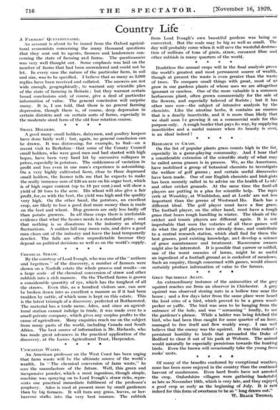RESEARCH IN GRASS.
On the list of popular plants grass counts high in the list,
especially in a game-playing community. And I hear that a considerable extension of the scientific study of what may be called arena grasses is in process. We, as the Americans, have mobilized a group of botanical chemists to investigate the welfare of golf greens ; and certain useful discoveries have been made. One of our English chemists and biologists has been recently called in to advise on the health of Lc rcli' and other cricket grounds. At the same time the footl all players are putting in a plea for scientific help. The tapis verts at Wembley, at Wimbledon, and at Lords' are not less important than the greens of Westward Ho. Each has a different ideal. The golf player must have a fine grass. The football player, on the other hand, must have a tough grass that bears rough handling in winter. The ideals of the cricket and tennis players are different again. It is not improbable that soon the votaries of all these games will do what the golf players have already done, and contribute to a central research station, which shall find for them the best grasses, pool existing knowledge, and develop a science of grass maintenance and treatment. Racecourse owners might also be interested. It is possible that yarrow or milfoil, one of the worst enemies of lawns, might be as useful an ingredient of a football ground as is cocksfoot of meadows. Such an enquiry, though concerned with games, would almost certainly produce information of value to the farmer.
*








































 Previous page
Previous page